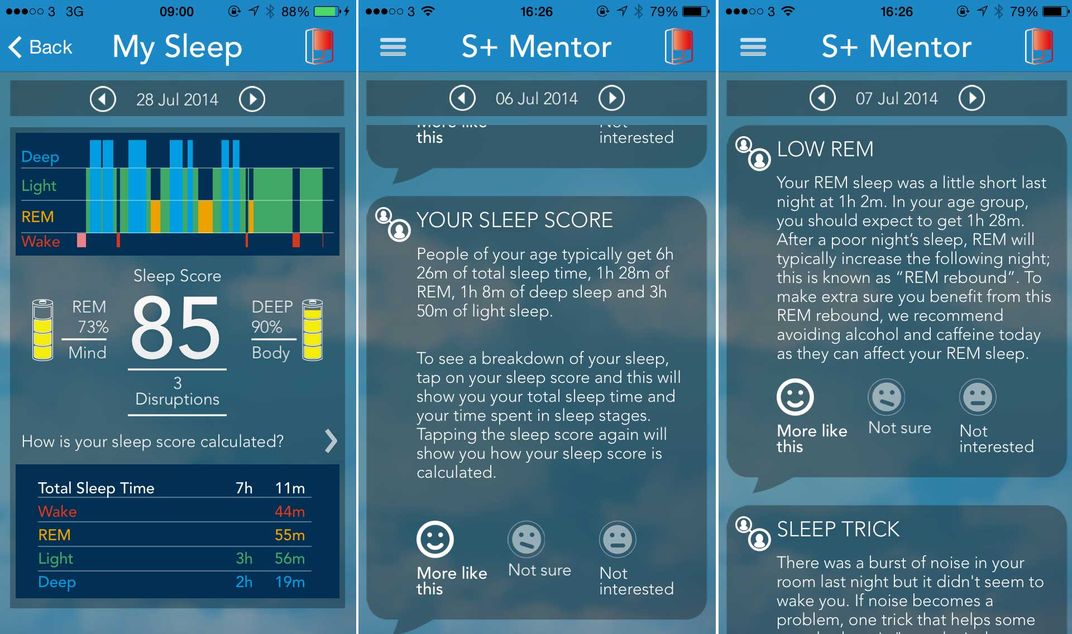This Device Tracks Your Sleep Without Ever Touching You
The ResMed S+ monitors your Zzzs from the comfortable distance of your nightstand and offers tips for getting a better rest
/https://tf-cmsv2-smithsonianmag-media.s3.amazonaws.com/filer/73/03/7303d075-9ce1-4381-afe8-259e22c17b5c/splus-bed.jpg)
More than one in three American adults, on average, get less than seven hours of sleep per night, according to a survey conducted by the Centers for Disease Control. But sleep problems, in general, are even more prevalent, says ResMed, a maker of sleep-apnea treatment solutions.
By ResMed's count, upwards of 60 percent of adults have mild to moderate trouble sleeping. That, according to its director of sales and marketing Matt Norton, includes people who have difficulty sleeping anywhere from one to five nights a week.
This month, the company introduced its solution: the ResMed S+, the first sleep monitor that guides users to a better night’s sleep without ever touching them. By logging hours slept, as well as the type of sleep—light, heavy, restless—the device can offer coaching tips to help users sleep longer and more soundly.
Standing about eight inches tall on a nightstand, the device uses a set of onboard sensors to monitor a sleeper's respiration and heart rate as well as the conditions in the room. At the heart of the S+ is a highly-tuned motion sensor, sensitive enough to detect a person’s heart rate and breathing patterns through a heavy down comforter and as far as four feet away. The device also has an ambient light sensor and a thermometer.
Users pair the S+ with their smartphone over Bluetooth and sync it with a ResMed app. Once paired, the system uses the phone’s microphone to track the room’s decibel level, without recording audio. At bedtime, users log the time when they lay down to sleep and that day’s activities in the app. For example, they would record whether or not they exercised that day or had a couple cocktails. Users can then opt to activate a feature called Relax to Sleep, which syncs soothing sounds—say, ocean waves crashing—with their breathing rate; gradually, the S+ decreases the frequency of the sounds, which, in turn, cues respiration to slow.
In the morning, the app sends sleep data to ResMed’s cloud server, which handles the heavy processing load. The app then displays a timeline of the night’s sleep, notes periods of deep or REM (rapid-eye movement) sleep and tallies how many disturbances users had throughout the night. All that data generates a sleep score (from 0 to 100).

Over time, the S+ finds patterns in a person's sleep and can help isolate factors that might be causing restlessness. Armed with that information, it offers tips to help improve the quality and duration of sleep. For instance, if someone didn’t have enough deep sleep—a time when the body recharges physically—and had little physical activity during the day, the app might recommend a walk 90 minutes before bedtime. If the person didn’t have enough mind-recharging REM sleep and had a couple of beers, the app might suggest refraining from alcohol for several hours before bed. Or, it will simply tell a user that it’s too hot, too loud or too bright in the bedroom.
“Our technology is clinically proven; we’ve been using it in medical devices for a number of years,” Norton says. The S+’s results match up with those of polysomnogram (PSG) tests, commonly used to monitor a patient’s respiration, heart rate and other factors during overnight clinical sleep studies. In fact, some medical institutions are already using ResMed's sensor for monitoring these types of vitals noninvasively, and the company believes it could be adapted further in the future.
Unfortunately, there are a couple concessions to be made. Although the S+ is smart enough to sense when a person lies down for bed, developers chose to have users manually enter their “to sleep” time; this tactic, says Norton, eliminates false positives, such as a pet hopping on the bed for an afternoon nap. Co-sleepers will also need to make allowances. Two S+ units in the same room can have crosstalk that may cause inaccurate results, so partners must either focus on one person or trade off nights.
ResMed S+ is a consumer device, so it won’t diagnose medical sleep disorders, such as apnea. But an upcoming software update will tell users when they should see a doctor about sleep troubles. “If, after a number of weeks, you don’t see your sleep improving, we’ll prompt [you] to download a sleep report and take it to a physician,” Norton explains.
The S+ is part of a recent glut of sleep monitors—the natural evolution of the fitness tracker market, says Norton. The Withings Aura, for example, uses color-changing light to influence the body’s level of melatonin production. It tracks sleep patterns through a motion-sensing pad between a mattress and bedding. Other devices, such as the Basis Band and the Jawbone UP, monitor vitals through a watch or wristband. The SleepRate app requires a user to wear a heart rate monitor around his or her chest.
Although the S+ has been undergoing in-home trials for about two years, ResMed hasn’t released any hard data on how much sleep users can expect to gain. The device is available now for $150.
/https://tf-cmsv2-smithsonianmag-media.s3.amazonaws.com/accounts/headshot/me.jpg)
/https://tf-cmsv2-smithsonianmag-media.s3.amazonaws.com/accounts/headshot/me.jpg)